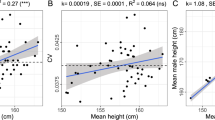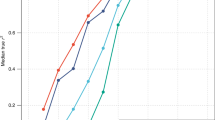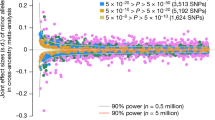Abstract
Height is a classic polygenic quantitative trait with a high level of heritability. As it is a simple and stable parameter to measure, height is a model for both common, complex disorders and monogenic, Mendelian disease. In this Review, we examine height from the perspective of monogenic and complex genetics and discuss the lessons learned so far. We explore several examples of rare sequence variants with large effects on height and compare these variants to the common variants identified in genome-wide association studies that have small effects on height. We discuss how copy number changes or genetic interactions might contribute to the unidentified aspects of the heritability of height. We also ask whether information derived from genome-wide association studies on specific loci in the vicinity of genes can be used for further research in clinical paediatric endocrinology. Furthermore, we address key challenges that remain for gene discovery and for the transition of moving from genomic localization to mechanistic insights, with an emphasis on using next-generation sequencing to identify causative variants of people at the extremes of height distribution.
Key Points
-
Height is a classic polygenic trait and a very good model for both common, complex disorders and monogenic, Mendelian disease
-
Extremes in height are often caused by monogenic mutations in one of the genes critical for control of growth
-
The role of four prominent genes implicated in growth control illustrates the diversity of the different pathways involved; progress on therapeutic options depends on the underlying gene defect and mechanism
-
Variations within the normal range of height are associated with common variants that have been uncovered by genome-wide association studies (GWAS); a discrepancy still exists between heritability and the identified loci
-
Comparison of common variants detected by GWAS and genes with a role in monogenic short stature shows some overlap; GWAS might pinpoint further genes that cause monogenic short stature
-
Next-generation sequencing will probably replace GWAS and thus yield insight into the genetic pathways involved in monogenic and complex disorders
This is a preview of subscription content, access via your institution
Access options
Subscribe to this journal
Receive 12 print issues and online access
$209.00 per year
only $17.42 per issue
Buy this article
- Purchase on Springer Link
- Instant access to full article PDF
Prices may be subject to local taxes which are calculated during checkout



Similar content being viewed by others
References
Judge, T. A. & Cable, D. M. The effect of physical height on workplace success and income: preliminary test of a theoretical model. J. Appl. Psychol. 89, 428–441 (2004).
Silventoinen, K. Determinants of variation in adult body height. J. Biosoc. Sci. 35, 263–285 (2003).
Silventoinen, K. et al. Heritability of adult body height: a comparative study of twin cohorts in eight countries. Twin Res. 6, 399–408 (2003).
Macgregor, S., Cornes, B. K., Martin, N. G. & Visscher, P. M. Bias, precision and heritability of self-reported and clinically measured height in Australian twins. Hum. Genet. 120, 571–580 (2006).
Lango Allen, H. et al. Hundreds of variants clustered in genomic loci and biological pathways affect human height. Nature 467, 832–838 (2010).
Godfrey, M. & Hollister, D. W. Type II achondrogenesis-hypochondrogenesis: identification of abnormal type II collagen. Am. J. Hum. Genet. 43, 904–913 (1998).
Vissing, H. et al. Glycine to serine substitution in the triple helical domain of pro-alpha 1 (II) collagen results in a lethal perinatal form of short-limbed dwarfism. J. Biol. Chem. 264, 18265–18267 (1989).
Shiang, R. et al. Mutations in the transmembrane domain of FGFR3 cause the most common genetic form of dwarfism, achondroplasia. Cell 78, 335–342 (1994).
Rao, E. et al. Pseudoautosomal deletions encompassing a novel homeobox gene cause growth failure in idiopathic short stature and Turner syndrome. Nat. Genet. 16, 54–63 (1997).
Tartaglia, M. et al. Mutations in PTPN11, encoding the protein tyrosine phosphatase SHP-2, cause Noonan syndrome. Nat. Genet. 29, 465–468 (2001).
Raben, M. S. Treatment of a pituitary dwarf with human growth hormone. J. Clin. Endocrinol. Metab. 18, 901–903 (1958).
Ranke, M., Weber, B. & Bierich, J. R. Long-term response to human growth hormone in 36 children with idiopathic growth hormone deficiency. Eur. J. Pediatr. 132, 221–238 (1979).
Phillips, J. A. 3rd, Hjelle, B. L., Seeburg, P. H. & Zachmann, M. Molecular basis for familial isolated growth hormone deficiency. Proc. Natl Acad. Sci. USA 78, 6372–6375 (1981).
Mullis, P. E. Genetic control of growth. Eur. J. Endocrinol. 152, 11–31 (2005).
Prince, K. L., Walvoord, E. C. & Rhodes, S. J. The role of homeodomain transcription factors in heritable pituitary disease. Nat. Rev. Endocrinol. 7, 727–737 (2011).
Sherlock, M., Woods, C. & Sheppard, M. C. Medical therapy in acromegaly. Nat. Rev. Endocrinol. 7, 291–300 (2011).
Ribeiro-Oliveira, A. Jr. & Barkan, A. The changing face of acromegaly-advances in diagnosis and treatment. Nat. Rev. Endocrinol. 8, 605–611 (2012).
Horton, W. A., Hall, J. G. & Hecht, J. T. Achondroplasia. Lancet 370, 162–172 (2007).
Rousseau, F. et al. Mutations in the gene encoding fibroblast growth factor receptor-3 in achondroplasia. Nature 371, 252–254 (1994).
Tavormina, P. L. et al. Thanatophoric dysplasia (types I and II) caused by distinct mutations in fibroblast growth factor receptor 3. Nat. Genet. 9, 32–38 (1995).
Bellus, G. A. et al. A recurrent mutation in the tyrosine kinase domain of fibroblast growth factor receptor 3 causes hypochondroplasia. Nat. Genet. 10, 357–359 (1995).
Rousseau, F. et al. Stop codon FGFR3 mutations in thanatophoric dwarfism type 1. Nat. Genet. 10, 11–12 (1995).
Rousseau, F. et al. Missense FGFR3 mutations create cysteine residues in thanatophoric dwarfism type I (TD1). Hum. Mol. Genet. 5, 509–512 (1996).
Toydemir, R. M. et al. A novel mutation in FGFR3 causes campodactyly, tall stature, and hearing loss (CATSHL) syndrome. Am. J. Hum. Genet. 79, 935–941 (2006).
Belin, V. et al. SHOX mutations in dyschondrosteosis (Leri–Weill syndrome). Nat. Genet. 19, 67–69 (1998).
Shears, D. J. et al. Mutation and deletion of the pseudoautosomal gene SHOX cause Leri–Weill dyschondrosteosis. Nat. Genet. 19, 70–73 (1998).
Rappold, G. et al. Genotypes and phenotypes in children with short stature: clinical indicators of SHOX haploinsufficiency. J. Med. Genet. 44, 306–313 (2007).
Rosilio, M. et al. Genotypes and phenotypes of children with SHOX deficiency in France. J. Clin. Endocrinol. Metab. 97, E1257–E1265 (2012).
Marchini, A. et al. The short stature homeodomain protein SHOX induces cellular growth arrest and apoptosis and is expressed in human growth plate chondrocytes. J. Biol. Chem. 279, 37103–37114 (2004).
Ottesen, A. M. et al. Increased number of sex chromosomes affects height in a nonlinear fashion: a study of 305 patients with sex chromosome aneuploidy. Am. J. Med. Genet. A 152A, 1206–1212 (2010).
Kanaka-Gantenbein, C. et al. Tall stature, insulin resistance, and disturbed behavior in a girl with the triple X syndrome harboring three SHOX genes: offspring of a father with mosaic Klinefelter syndrome but with two maternal X chromosomes. Horm. Res. 61, 205–210 (2004).
Ottesen, A. M. et al. Increased number of sex chromosomes affect height in a nonlinear fashion: a study of 305 patients with sex chromosome aneuploidy. Am. J. Med. Genet. 152A, 1206–1212 (2010).
Canadas, V., Vilacosta, I., Bruna, I. & Fuster, V. Marfan syndrome. Pathophysiology and diagnosis. Nat. Rev. Cardiol. 7, 256–265 (2010).
Le Goff, C. et al. Mutations in the TGFβ binding-protein-like domain 5 of FBN1 are responsible for acromicric and geleophysic dysplasias. Am. J. Hum. Genet. 89, 7–14 (2011).
Faivre, L. et al. In frame fibrillin-1 gene deletion in autosomal dominant Weill–Marchesani syndrome. J. Med. Genet. 40, 34–36 (2003).
Wit, J. M. Diagnosis and management of disorders of IGF-I synthesis and action. Pediatr. Endocrinol. Rev. 9 (Suppl. 1), 538–540 (2011).
David, A. et al. Evidence for a continuum of genetic, phenotypic, and biochemical abnormalities in children with growth hormone insensitivity. Endocr. Rev. 32, 472–497 (2011).
Domené, H. M. et al. Human acid-labile subunit deficiency: clinical, endocrine and metabolic consequences. Horm. Res. 72, 129–141 (2009).
Horton, W. A. Fibroblast growth factor receptor 3 and the human chondrodysplasias. Curr. Opin. Pediatr. 9, 437–442 (1997).
Aviezer, D., Golembo, M. & Yayon, A. Fibroblast growth factor receptor-3 as a therapeutic target for Achondroplasia--genetic short limbed dwarfism. Curr. Drug Targets 4, 353–365 (2003).
Jonquoy, A. et al. A novel tyrosine kinase inhibitor restores chondrocyte differentiation and promotes bone growth in a gain-of-function Fgfr3 mouse model. Hum Mol Genet. 21, 841–851 (2012).
Qing, J. et al. Antibody-based targeting of FGFR3 in bladder carcinoma and t(4;14)-positive multiple myeloma in mice. J. Clin. Invest. 119, 1216–1129 (2009).
Jin, M. et al. A novel FGFR3-binding peptide inhibits FGFR3 signaling and reverses the lethal phenotype of mice mimicking human thanatophoric dysplasia. Hum. Mol. Genet. 21, 5443–5455 (2012).
Yasoda, A. et al. Systemic administration of C-type natriuretic peptide as a novel therapeutic strategy for skeletal dysplasias. Endocrinology 150, 3138–3144 (2009).
Laederich, M. B. & Horton, W. A. FGFR3 targeting strategies for achondroplasia. Expert Rev. Mol. Med. 14, e11 (2012).
Binder, G. Short stature due to SHOX deficiency: genotype, phenotype, and therapy. Horm. Res. Paediatr. 75, 81–89 (2011).
Benito-Sanz, S. et al. A novel class of Pseudoautosomal region 1 deletions downstream of SHOX is associated with Leri–Weill dyschondrosteosis. Am. J. Hum. Genet. 77, 533–544 (2005).
Sabherwal, N. et al. Long-range conserved non-coding SHOX sequences regulate expression in developing chicken limb and are associated with short stature phenotypes in human patients. Hum. Mol. Genet. 16, 210–22 (2007).
Blum, W. F. et al. Growth hormone is effective in treatment of short stature associated with short stature homeobox-containing gene deficiency: Two-year results of a randomized, controlled, multicenter trial. J. Clin. Endocrinol. Metab. 92, 219–228 (2007).
Brooke, B. S. et al. Angiotensin II blockade and aortic-root dilation in Marfan's syndrome. N. Engl. J. Med. 358, 2787–2795 (2008).
Bolar, N., Van Laer, L., & Loeys, B. L. Marfan syndrome: from gene to therapy. Curr. Opin. Pediatr. 24, 498–504 (2012).
Neptune, E. R. et al. Dysregulation of TGF-β activation contributes to pathogenesis in Marfan syndrome. Nat. Genet. 33, 407–411 (2003).
Loeys, B. L. et al. Aneurysm syndromes caused by mutations in the TGF-β receptor. N. Engl. J. Med. 355, 788–798 (2006).
Holm, T. M. et al. Noncanonical TGFβ signaling contributes to aortic aneurysm progression in Marfan syndrome mice. Science 332, 358–361 (2011).
Habashi, J. P. et al. Losartan, an AT1 antagonist, prevents aortic aneurysm in a mouse model of Marfan syndrome. Science 312, 117–121 (2006).
Akhurst, R. J. & Hata, A. Targeting the TGFβ signalling pathway in disease. Nat. Rev. Drug Discov. 11, 790–811 (2012).
Weedon, M. N. et al. A common variant of HMGA2 is associated with adult and childhood height in the general population. Nat. Genet. 39, 1245–1250 (2007).
Zhou, X., Benson, K. F., Ashar, H. R. & Chada, K. Mutation responsible for the mouse pygmy phenotype in the developmentally regulated factor HMGI.-C. Nature 376, 771–774 (1995).
Gudbjartsson, D. F. et al. Many sequence variants affecting diversity of adult human height. Nat. Genet. 40, 609–615 (2008).
Lettre, G. et al. Identification of ten loci associated with height highlights new biological pathways in human growth. Nat. Genet. 40, 584–591 (2008).
Weedon, M. N. et al. Genome-wide association analysis identifies 20 loci that influence adult height. Nat. Genet. 40, 575–583 (2008).
Sanna, S. et al. Common variants in the GDF5-UQCC region are associated with variation in human height. Nat. Genet. 40, 198–203 (2008).
Estrada, K. et al. A genome-wide association study of northwestern Europeans involves the C-type natriuretic peptide signaling pathway in the etiology of human height variation. Hum. Mol. Genet. 18, 3516–3524 (2009).
Soranzo, N. et al. Meta-analysis of genome-wide scans for human adult stature identifies novel Loci and associations with measures of skeletal frame size. PLoS Genet. 5, e1000445 (2009).
Johansson, A. et al. Common variants in the JAZF1 gene associated with height identified by linkage and genome-wide association analysis. Hum. Mol. Genet. 18, 373–380 (2009).
Kim, J. J. et al. Identification of 15 loci influencing height in a Korean population. J. Hum. Genet. 55, 27–31 (2010).
Okada, Y. et al. A genome-wide association study in 19 633 Japanese subjects identified LHX3-QSOX2 and IGF1 as adult height loci. Hum. Mol. Genet. 19, 2303–2312 (2010).
Cho, Y. S. et al. A large-scale genome-wide association study of Asian populations uncovers genetic factors influencing eight quantitative traits. Nat. Genet. 41, 527–534 (2009).
Yang, J. et al. Conditional and joint multiple-SNP analysis of GWAS summary statistics identifies additional variants influencing complex traits. Nat. Genet. 44, 369–375 (2012).
Lanktree, M. B. et al. Meta-analysis of dense genecentric association studies reveals common and uncommon variants associated with height. Am. J. Hum. Genet. 88, 6–18 (2011).
Gibson, G. Rare and common variants: twenty arguments. Nat. Rev. Genet. 13, 135–145 (2012).
Alkan, C., Coe, B. P. & Eichler, E. E. Genome structural variation discovery and genotyping. Nat. Rev. Genet. 12, 363–376 (2011).
Dauber, A. et al. Genome-wide association of copy-number variation reveals an association between short stature and the presence of low-frequency genomic deletions. Am. J. Hum. Genet. 89, 751–759 (2011).
Pinto, D. et al. Functional impact of global rare copy number variation in autism spectrum disorders. Nature 466, 368–372 (2010).
International Schizophrenia Consortium. Rare chromosomal deletions and duplications increase risk of schizophrenia. Nature 455, 237–241 (2008).
Zuk, O., Hechter, E., Sunyaev, S. R. & Lander, E. S. The mystery of missing heritability: Genetic interactions create phantom heritability. Proc. Natl Acad. Sci. USA 109, 1193–1198 (2012).
Yang, J. et al. Genome partitioning of genetic variation for complex traits using common SNPs. Nat. Genet. 43, 519–525 (2011).
Slatkin, M. Epigenetic inheritance and the missing heritability problem. Genetics 182, 845–850 (2009).
Weinstein, M., Xu, X., Ohyama, K. & Deng, C. X. FGFR-3 and FGFR-4 function cooperatively to direct alveogenesis in the murine lung. Development 125, 3615–3623 (1998).
Lettre, G. Recent progress in the study of the genetics of height. Hum. Genet. 129, 465–472 (2011).
Chan, Y. et al. Common variants show predicted polygenic effects on height in the tails of the distribution, except in extremely short individuals. PLoS Genet. 7, e1002439 (2011).
Acknowledgements
We thank J.-M. Wit, P. Propping, H. Cooke, W. Blum and C. Haley for discussion on the manuscript.
Author information
Authors and Affiliations
Contributions
Both authors contributed to all aspects of the article.
Corresponding author
Ethics declarations
Competing interests
The authors declare no competing financial interests.
Supplementary information
Supplementary Table 1
List of genes identified in the OMIM database using the keyword overgrowth, in alphabetical order. (DOC 76 kb)
Supplementary Table 2
List of genes identified in the OMIM database using the keyword short stature, in alphabetical order. (DOC 481 kb)
Rights and permissions
About this article
Cite this article
Durand, C., Rappold, G. Height matters—from monogenic disorders to normal variation. Nat Rev Endocrinol 9, 171–177 (2013). https://doi.org/10.1038/nrendo.2012.251
Published:
Issue Date:
DOI: https://doi.org/10.1038/nrendo.2012.251
This article is cited by
-
Identification of novel genetic variants associated with short stature in a Baka Pygmies population
Human Genetics (2020)
-
Closing the ‘phenotype gap’ in precision medicine: improving what we measure to understand complex disease mechanisms
Mammalian Genome (2019)
-
Functional missense and splicing variants in the retinoic acid catabolizing enzyme CYP26C1 in idiopathic short stature
European Journal of Human Genetics (2018)
-
Distinct Genetic Influences on Cortical and Subcortical Brain Structures
Scientific Reports (2016)
-
Mutations in the DNA methyltransferase gene DNMT3A cause an overgrowth syndrome with intellectual disability
Nature Genetics (2014)



